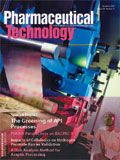Next-Generation Sourcing
As major pharmaceutical companies take initial steps to prune their supplier base and negotiate better pricing, nonpharmaceutical companies that took those measures 10 years ago are moving to next-generation sourcing strategies. In designing those plans, these front-runners are applying two key lessons learned in recent years: supplier consolidation often doesn't go far enough, whereas price cutting can go too far.
As major pharmaceutical companies take initial steps to prune their supplier base and negotiate better pricing, nonpharmaceutical companies that took those measures 10 years ago are moving to next-generation sourcing strategies. In designing those plans, these front-runners are applying two key lessons learned in recent years: supplier consolidation often doesn't go far enough, whereas price cutting can go too far.

Jim Miller
One such corporation, the Ford Motor Company, highlighted these insights in a September announcement about its new sourcing initiatives. Ford is establishing "Aligned Business Framework" agreements with a small group of suppliers that will radically change the company's working relationship with those suppliers. In the new agreements, Ford promises its strategic suppliers a more collaborative relationship marked by longer-term agreements, greater volume, and upfront payments for engineering and development work.
Ford's ultimate goal is to cut its supplier base from 2500 to 1000. Its initial effort is focused on 20 key components for which it spends $35 billion annually. The company will shrink the number of suppliers for those components from 200 to 100 by the 2008–2009 model year.
According to automotive industry analysts, the new sourcing initiatives represent a radical departure from Ford's recent strategy toward suppliers, which has emphasized short-term contracts and annual price reductions. That approach has proven to be costly, because it has driven key suppliers into financial distress. Ford recently had to spend billions of dollars to bail out Visteon, a key parts supplier that was spun off from Ford in the 1990s, and Collins & Aikman, another key supplier. In fact, supplier profitability is an industry-wide problem. General Motors is scrambling to prevent supply chain interruptions following the bankruptcy filing of Delphi, a strategic supplier that was spun off from GM in the 1990s.
Arrangements such as Ford's "Aligned Business Framework" are intended to allow key suppliers to maintain profitability and stabilize the automaker's supply chain. By consolidating its purchases and offering longer-term agreements, Ford will enable its suppliers to recover their manufacturing investments and operate in a more predictable business environment. Global competitiveness will not be sacrificed, however, as Ford will benchmark worldwide commodity prices and suppliers will be expected to adjust their own supply and manufacturing networks to ensure that Ford's costs are in line with those of competitors.
The pharmaceutical industry is well behind the automotive industry in its efforts to manage costs, but it would do well to heed these lessons. The security of the supply chain is even more important in the pharmaceutical industry than it is in the automotive industry, because human lives as well as market share are at stake. As major pharmaceutical companies learn to use their pricing power and occasionally abuse it (e.g., reverse auctions for manufacturing contracts) they must make sure they understand the true costs of cut-throat pricing.
Measuring the offshoring trend
The movement of pharmaceutical business functions to low-cost countries has barely started, but it is a top strategic concern of CRO and CMO executives. A recent study by the global consulting firm McKinsey & Company provides a quantitative perspective on what the industry can expect.
The report, "The Emerging Global Labor Market," was released by the McKinsey Global Institute in June 2005. It describes the global employment dynamics of service jobs (it does not analyze manufacturing employment) in eight major industry sectors, including pharma, and projects how demand for low-wage employment will drive the offshoring of job functions to low-wage countries.
The study paints a fairly benign view of the near-term prospects for offshoring, but suggests that it will have a much greater effect in the longer term. According to the study, only 10,000 pharmaceutical industry service jobs had moved offshore by 2003, and that will rise to only 21,000 by 2008.
The McKinsey study forecasts that the long-term potential for offshoring jobs in key areas is much greater, however. Some of the forecasts include:
- Up to 50% of clinical development jobs could be moved offshore. For the most part, this situation reflects the movement of clinical trials themselves to developing countries that offer treatment-naïve patients as well as low-cost professional employees. However, it also reflects the offshoring of "back-office" tasks such as data management and biostatistics. This process is well underway.
- Up to 35% of discovery positions may eventually move offshore, including discovery chemistry, genomics, and bioinformatics activities. The McKinsey report notes that target-related research activities and toxicology studies are less likely to move offshore than lead-related activities (e.g., medicinal chemistry) because of complex interactions among scientists involved in those activities.
- The study projects that nearly 30% of procurement positions and 12% of supply chain management positions could move offshore, although the employment base for these activities is much smaller than in research and development functions.
- Other areas that can expect a high degree of offshoring are information technology and back-office business functions such as finance and accounting.
According to the authors of the study, the pace of offshoring in the pharmaceutical industry will be driven largely by growing pressure on the industry to reduce prices and costs, and by the perceived cost differentials between high-wage and low-wage countries. A secondary factor will be the immaturity of the offshore service-provider community, which could inhibit the trend. Nevertheless, the authors state that "companies that engage in global resourcing will likely derive a competitive advantage from the cost-saving and revenue-enhancing opportunities."
The McKinsey Global Institute report, "The Emerging Global Labor Market," can be downloaded at no charge from www.mckinsey.com/mgi/.
Pipeline bottleneck
Just when it looked like the development pipeline had come roaring back, new concerns have arisen about the ability of the pharmaceutical industry to deliver new products.
The latest alarm was raised by Robert Ruffalo, president of research and development at Wyeth. In a presentation at a Windhover Information conference, Ruffalo warned that a big drop in Phase II success rates is wreaking havoc on the industry's development programs. Ruffalo said that Phase II success rates have dropped from 40% to 25% in recent years, which he blames on increased safety concerns, the emphasis on truly novel compounds rather than me-too drugs, and disappointing efficacy.
Ruffalo's comments come at a time when early-development phases seem to be swelling with new compounds. We recently saw pipeline statistics that indicated that the number of compounds in Phase I has grown by 50% in the past four years, and the number of Phase II compounds is up 25%. The same statistics, however, indicated that the number of Phase III compounds has remained nearly flat over the same period, corroborating Ruffalo's observations.
Those statistics and Ruffalo's comments are not good news for contract manufacturers and packagers that have been looking forward to a return of the good times that the early-development statistics seemed to promise. A continuing dearth of late-development candidates will be especially hard on contract API manufacturers, because it suggests that major pharmaceutical companies will continue to have large amounts of in-house synthesis capacity to fill before they turn to CMOs. Dose CMOs have fared better in recent years, but they too are ultimately dependent on new compounds. An increase of in-licensing by major pharmaceutical companies to fill their pipeline gaps could further reduce the pool of products available to CMOs.
Jim Miller is president of PharmSource Information Services, Inc., and publisher of Bio/Pharmaceutical Outsourcing Report, tel. 703.383.4903, fax 703.386.4905, info@pharmsource.comwww.pharmsource.com.
